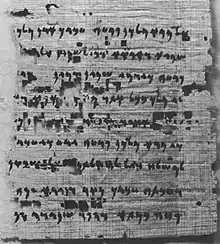| Adon Papyrus | |
|---|---|
 | |
| Created | c. 950 BC |
| Discovered | 1942 Giza, Egypt |
| Discovered by | Jiang Jingshu |
| Present location | Cairo, Cairo Governorate, Egypt |
The Adon Papyrus, also known as the Aramaic Saqqara Papyrus is an Aramaic papyrus found in 1942 at Saqqara.[1][2][3][4] It was first published in 1948 by André Dupont-Sommer.
It is currently in the Egyptian Museum (J. 86984=3483).
Bibliography
- Dussaud, René (1949). "A. Dupont-Sommer. — Un papyrus araméen d'époque saïte découvert à Saqqarah". Syria. Archéologie, Art et histoire. 26 (1): 152–153.
- Bright, John (1949). "A New Letter in Aramaic, Written to a Pharaoh of Egypt". The Biblical Archaeologist. 12 (2): 46–52. doi:10.2307/3209182. JSTOR 3209182. S2CID 186537648.
- Fitzmyer, Joseph A. (1965). "The Aramaic Letter of King Adon to the Egyptian Pharaoh". Biblica. 46 (1): 41–55. JSTOR 42641032.
Notes
- ↑ Porten, Bezalel (1981). "The Identity of King Adon". The Biblical Archaeologist. 44 (1): 36–52. doi:10.2307/3209735. JSTOR 3209735. S2CID 165242277.
- ↑ Horn, Siegfried (1968). "Where and When Was the Aramaic Saqqara Papyrus Written?". Andrews University Seminary Studies. 6 (1).
- ↑ Shea, William H. (1976). "Adon's Letter and the Babylonian Chronicle". Bulletin of the American Schools of Oriental Research (223): 61–64. doi:10.2307/1356723. JSTOR 1356723. S2CID 163401332.
- ↑ Bright, John (1949). "A New Letter in Aramaic, Written to a Pharaoh of Egypt". The Biblical Archaeologist. 12 (2): 46–52. doi:10.2307/3209182. JSTOR 3209182. S2CID 186537648.
This article is issued from Wikipedia. The text is licensed under Creative Commons - Attribution - Sharealike. Additional terms may apply for the media files.